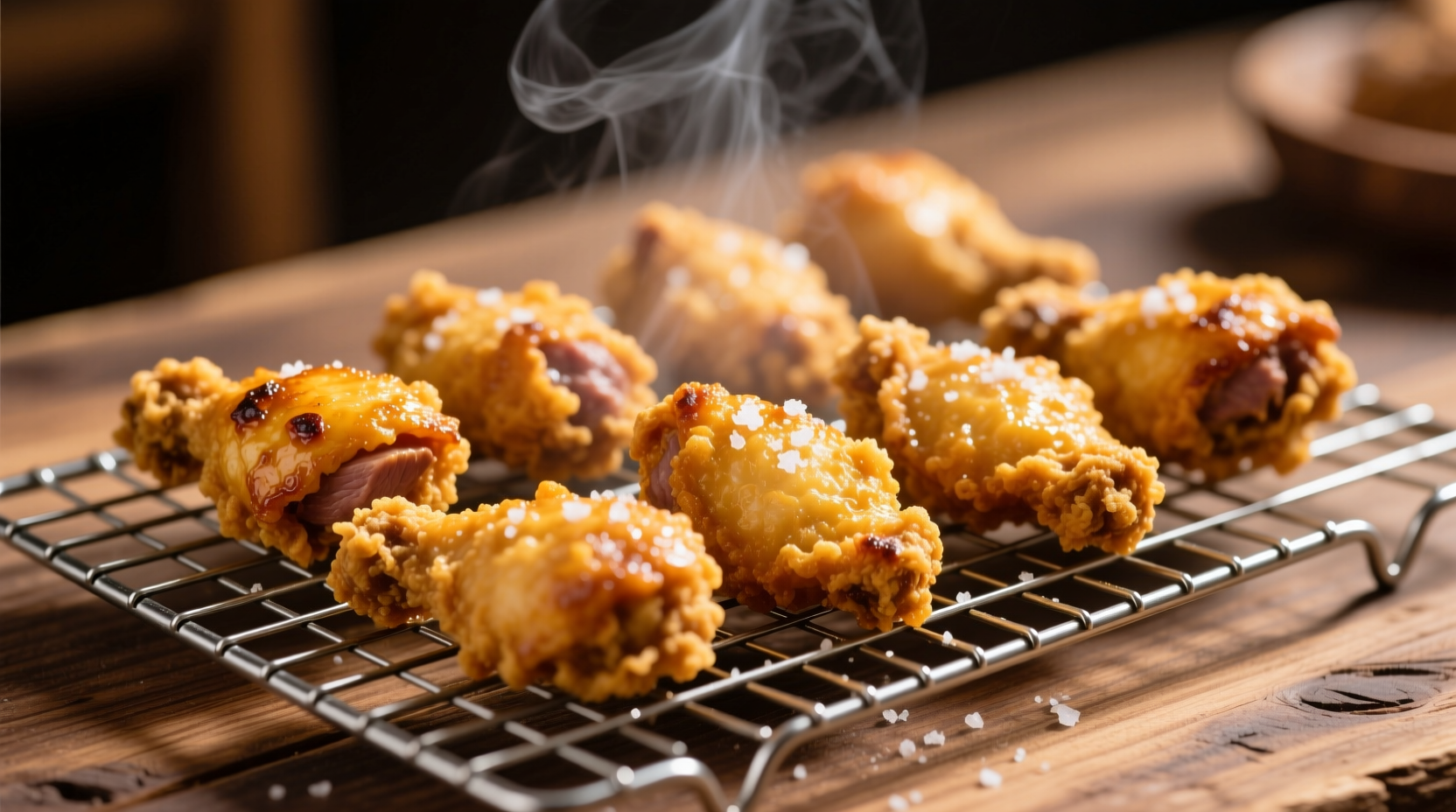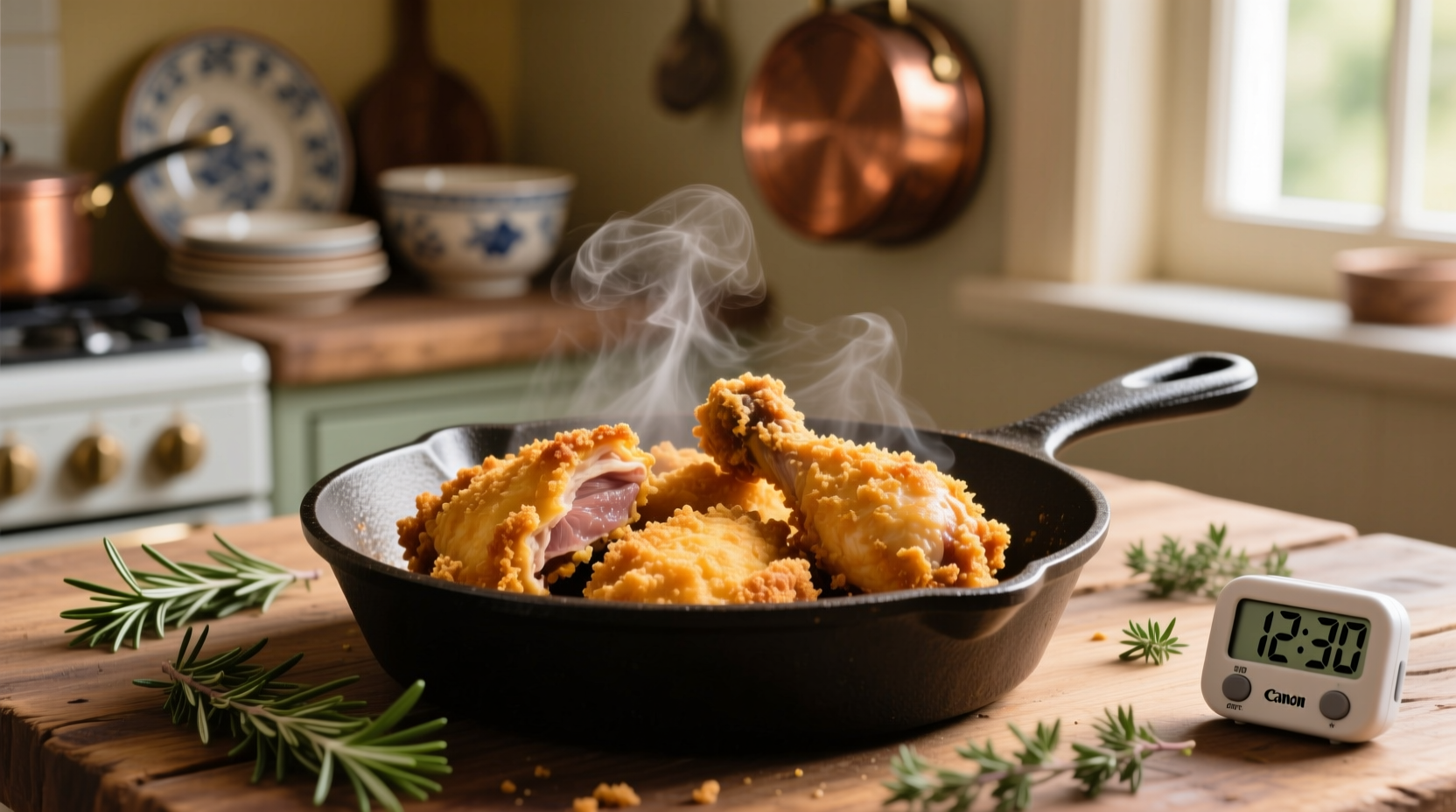Perfectly cooked fried chicken delivers that irresistible golden crunch while staying juicy inside. Get it wrong, and you'll face either raw poultry or dry, overcooked meat. This guide cuts through the confusion with precise timing guidelines backed by food science and professional kitchen experience. You'll learn exactly how long to cook fried chicken for safety and quality, plus practical verification methods beyond just timing.
The Science Behind Fried Chicken Timing
Timing alone isn't enough for perfect fried chicken. The magic happens through precise heat transfer. When chicken hits hot oil (ideally 350°F), the surface moisture instantly vaporizes, creating that signature sizzle while forming a protective crust. This crust seals in juices while the interior cooks through conduction. Too low oil temperature causes greasy absorption; too high burns the coating before the inside cooks.
According to USDA Food Safety and Inspection Service guidelines, poultry must reach 165°F internal temperature to eliminate harmful bacteria like salmonella. This critical threshold hasn't changed since the 1990s when digital thermometers became mainstream kitchen tools, replacing unreliable methods like checking juice color.
Fried Chicken Cooking Time Reference Guide
| Chicken Cut | Oil Temperature | Approximate Time | Internal Temp |
|---|---|---|---|
| Breast pieces (6-8 oz) | 350°F (175°C) | 12-15 minutes | 165°F (74°C) |
| Thighs/Drumsticks | 325-350°F (163-175°C) | 15-18 minutes | 170°F (77°C) |
| Wings | 375°F (190°C) | 8-10 minutes | 165°F (74°C) |
| Air Fryer (all cuts) | 375°F (190°C) | 18-22 minutes | 165°F (74°C) |
Factors That Change Your Cooking Timeline
Your actual fried chicken cooking time varies based on several critical factors:
- Chicken thickness - A thick chicken breast needs 3-5 minutes longer than a thin cutlet
- Starting temperature - Refrigerated chicken adds 2-3 minutes versus room-temperature pieces
- Oil temperature stability - Dropping below 325°F significantly extends cooking time
- Breading composition - Heavy coatings like cornflake crusts require slightly lower heat
- Cooking equipment - Cast iron maintains heat better than thin pans
Professional kitchens consistently achieve perfect results by monitoring oil temperature with a clip-on thermometer and checking internal temperature with an instant-read probe. Don't rely solely on timing—these verification methods prevent food safety risks.
How to Verify Perfect Doneness (Beyond Timing)
Timing provides a starting point, but these verification methods ensure safety and quality:
- Internal temperature check - Insert thermometer into thickest part (avoiding bone) - 165°F is non-negotiable for safety
- Visual inspection - Golden brown color with no pink hues near bone joints
- Texture test - Juices should run clear when pierced, not pink
- Float test - Properly cooked pieces will float in hot oil (though less reliable than thermometer)

Troubleshooting Common Timing Issues
Problem: Burnt exterior, raw interior
Solution: Oil temperature too high. Reduce heat to 325°F and extend cooking time. Maintain consistent oil temperature by not overcrowding the pot.
Problem: Greasy, soggy coating
Solution: Oil temperature dropped too low during cooking. Heat oil back to 350°F between batches and ensure chicken is thoroughly dried before breading.
Problem: Uneven cooking
Solution: Inconsistent piece sizes. Cut chicken to uniform thickness or cook similar-sized pieces together. Dark meat requires slightly longer than white meat.
Pro Tips for Foolproof Fried Chicken
Seasoned chefs use these techniques for consistent results:
- Rest cooked chicken on a wire rack for 5 minutes before serving - this lets residual heat finish cooking while keeping the crust crisp
- Use a dedicated fry thermometer - guessing oil temperature leads to inconsistent results
- Double-fry method: First fry at 300°F for 8 minutes, rest 10 minutes, then refry at 375°F for 2-3 minutes for extra-crispy results
- Pat chicken completely dry before breading - moisture causes oil to splatter and prevents crisp coating
Remember that carryover cooking continues after removal from oil. Pull chicken at 160°F to reach the safe 165°F during resting. This prevents overcooking while ensuring food safety.
Frequently Asked Questions
How long to cook fried chicken at 375 degrees?
At 375°F, fried chicken requires 10-12 minutes for breasts and 12-15 minutes for thighs/drumsticks. Higher heat creates faster browning but requires careful monitoring to prevent burning before the interior cooks through. Always verify with a meat thermometer.
Can I tell if fried chicken is done without a thermometer?
While less reliable than a thermometer, you can check by cutting into the thickest part near the bone - juices should run clear with no pink color. The meat should separate easily from the bone and feel firm but not rubbery. However, USDA recommends using a thermometer as visual methods can be inaccurate.
Why is my fried chicken taking longer than expected to cook?
Common reasons include oil temperature dropping below 325°F, overcrowding the fryer (which lowers oil temperature), starting with very cold chicken, or using thick cuts. Maintain oil temperature between 325-350°F and cook in small batches for consistent results.
How long should fried chicken rest before serving?
Rest fried chicken for 5-10 minutes on a wire rack before serving. This allows residual heat to finish cooking the interior to safe temperatures while keeping the crust crisp. Resting also lets juices redistribute throughout the meat for maximum juiciness.











 浙公网安备
33010002000092号
浙公网安备
33010002000092号 浙B2-20120091-4
浙B2-20120091-4